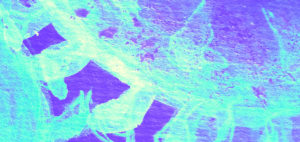This is Your Brain on Nature

Hikers with backpacks walking through a meadow with lush grass
When you head out to the desert, David Strayer is the kind of man you want behind the wheel. He never texts or talks on the phone while driving. He doesn’t even approve of eating in the car. A cognitive psychologist at the University of Utah who specializes in attention, Strayer knows our brains are prone to mistakes, especially when we’re multitasking and dodging distractions. Among other things, his research has shown that using a cell phone impairs most drivers as much as drinking alcohol does.
Strayer is in a unique position to understand what modern life does to us. An avid backpacker, he thinks he knows the antidote: Nature.
On the third day of a camping trip in the wild canyons near Bluff, Utah, Strayer is mixing up an enormous iron kettle of chicken enchilada pie while explaining what he calls the “three-day effect” to 22 psychology students. Our brains, he says, aren’t tireless three-pound machines; they’re easily fatigued. When we slow down, stop the busywork, and take in beautiful natural surroundings, not only do we feel restored, but our mental performance improves too. Strayer has demonstrated as much with a group of Outward Bound participants, who performed 50 percent better on creative problem-solving tasks after three days of wilderness backpacking. The three-day effect, he says, is a kind of cleaning of the mental windshield that occurs when we’ve been immersed in nature long enough. On this trip he’s hoping to catch it in action, by hooking his students—and me—to a portable EEG, a device that records brain waves.
“On the third day my senses recalibrate—I smell things and hear things I didn’t before,” Strayer says. The early evening sun has saturated the red canyon walls; the group is mellow and hungry in that satisfying, campout way. Strayer, in a rumpled T-shirt and with a slight sunburn, is definitely looking relaxed. “I’m more in tune with nature,” he goes on. “If you can have the experience of being in the moment for two or three days, it seems to produce a difference in qualitative thinking.”
Strayer’s hypothesis is that being in nature allows the prefrontal cortex, the brain’s command center, to dial down and rest, like an overused muscle. If he’s right, the EEG will show less energy coming from “midline frontal theta waves”—a measure of conceptual thinking and sustained attention. He’ll compare our brain waves with those of similar volunteers who are sitting in a lab or hanging out at a parking lot in downtown Salt Lake City.
While the enchiladas are cooking, Strayer’s graduate students tuck my head into a sort of bathing cap with 12 electrodes embedded in it. They suction-cup another 6 electrodes to my face. Wires sprouting from them will send my brain’s electrical signals to a recorder for later analysis. Feeling like a beached sea urchin, I walk carefully to a grassy bank along the San Juan River for ten minutes of restful contemplation. I’m supposed to think of nothing in particular, just watch the wide, sparkling river flow gently by. I haven’t looked at a computer or cell phone in days. It’s easy to forget for a few moments that I ever had them.
In 1865 the great landscape architect Frederick Law Olmsted looked out over the Yosemite Valley and saw a place worth saving. He urged the California legislature to protect it from rampant development. Olmsted had already designed Central Park in New York City; he was convinced that beautiful green spaces should exist for all people to enjoy. “It is a scientific fact,” he wrote, “that the occasional contemplation of natural scenes of an impressive character … is favorable to the health and vigor of men and especially to the health and vigor of their intellect.”
Olmsted was exaggerating; his claim was based less on science than on intuition. But it was an intuition with a long history. It went back at least to Cyrus the Great, who some 2,500 years ago built gardens for relaxation in the busy capital of Persia. Paracelsus, the 16th-century German-Swiss physician, gave voice to that same intuition when he wrote, “The art of healing comes from nature, not from the physician.” In 1798, sitting on the banks of the River Wye, William Wordsworth marveled at how “an eye made quiet by the power / Of harmony” offered relief from “the fever of the world.” American writers such as Ralph Waldo Emerson and John Muir inherited that outlook. Along with Olmsted, they built the spiritual and emotional case for creating the world’s first national parks by claiming that nature had healing powers.
There wasn’t much hard evidence then—but there is now. Motivated by large-scale public health problems such as obesity, depression, and pervasive nearsightedness, all clearly associated with time spent indoors, Strayer and other scientists are looking with renewed interest at how nature affects our brains and bodies. Building on advances in neuroscience and psychology, they’ve begun to quantify what once seemed divine and mysterious. These measurements—of everything from stress hormones to heart rate to brain waves to protein markers—indicate that when we spend time in green space, “there is something profound going on,” as Strayer puts it.
In England researchers from the University of Exeter Medical School recently analyzed mental health data from 10,000 city dwellers and used high-resolution mapping to track where the subjects had lived over 18 years. They found that people living near more green space reported less mental distress, even after adjusting for income, education, and employment (all of which are also correlated with health). In 2009 a team of Dutch researchers found a lower incidence of 15 diseases—including depression, anxiety, heart disease, diabetes, asthma, and migraines—in people who lived within about a half mile of green space. And in 2015 an international team overlaid health questionnaire responses from more than 31,000 Toronto residents onto a map of the city, block by block. Those living on blocks with more trees showed a boost in heart and metabolic health equivalent to what one would experience from a $20,000 gain in income. Lower mortality and fewer stress hormones circulating in the blood have also been connected to living close to green space.
It’s difficult to tell from these kinds of studies why people feel better. Is it the fresh air? Do certain colors or fractal shapes trigger neurochemicals in our visual cortex? Or is it just that people in greener neighborhoods use the parks to exercise more? That’s what Richard Mitchell, an epidemiologist at the University of Glasgow in Scotland, thought at first. “I was skeptical,” he says. But then he did a large study that found less death and disease in people who lived near parks or other green space—even if they didn’t use them. “Our own studies plus others show these restorative effects whether you’ve gone for walks or not,” Mitchell says. Moreover, the lowest income people seemed to gain the most: In the city, Mitchell found, being close to nature is a social leveler.
Virtual nature is soothing too. Swedish researcher Matilda van den Bosch stresses her subjects with a math test and a simulated job interview. When she delivers them into a virtual forest with singing birds, their heart rate soon recovers its normal rhythm.
What he and other researchers suspect is that nature works primarily by lowering stress. Compared with people who have lousy window views, those who can see trees and grass have been shown to recover faster in hospitals, perform better in school, and even display less violent behavior in neighborhoods where it’s common. Such results jibe with experimental studies of the central nervous system. Measurements of stress hormones, respiration, heart rate, and sweating suggest that short doses of nature—or even pictures of the natural world—can calm people down and sharpen their performance.
In Sweden physician Matilda van den Bosch found that after a stressful math task, subjects’ heart rate variability—which decreases with stress—returned to normal more quickly when they sat through 15 minutes of nature scenes and birdsong in a 3-D virtual reality room than when they sat in a plain room. A real-life experiment is under way at the Snake River Correctional Institution in eastern Oregon. Officers there report calmer behavior in solitary confinement prisoners who exercise for 40 minutes several days a week in a “blue room” where nature videos are playing, compared with those who exercise in a gym without videos. “I thought it was crazy at first,” says corrections officer Michael Lea. But he has experienced the difference. “There’s a lot of yelling really loud— it echoes horribly,” in the plain gym, he says. “In the blue room they tend not to yell. They say, ‘Hold on, I got to watch my video.’”
A 15-minute walk in the woods causes measurable changes in physiology. Japanese researchers led by Yoshifumi Miyazaki at Chiba University sent 84 subjects to stroll in seven different forests, while the same number of volunteers walked around city centers. The forest walkers hit a relaxation jackpot: Overall they showed a 16 percent decrease in the stress hormone cortisol, a 2 percent drop in blood pressure, and a 4 percent drop in heart rate. Miyazaki believes our bodies relax in pleasant, natural surroundings because they evolved there. Our senses are adapted to interpret in- formation about plants and streams, he says, not traffic and high-rises.
All this evidence for the benefits of nature is pouring in at a time when disconnection from it is pervasive, says Lisa Nisbet, a psychology professor at Canada’s Trent University. We love our state and national parks, but per capita visits have been declining since the dawn of email. So have visits to the backyard. One recent Nature Conservancy poll found that only about 10 percent of American teens spend time outside every day. According to research by the Harvard School of Public Health, American adults spend less time outdoors than they do inside vehicles—less than 5 percent of their day.
Nature nurtures us. It boosts our mood too. According to the attention restoration theory, spending time in nature relieves the stress and mental fatigue caused by the “directed attention” that work and city life require.
“People underestimate the happiness effect” of being outdoors, Nisbet says. “We don’t think of it as a way to increase happiness. We think other things will, like shopping or TV. We evolved in nature. It’s strange we’d be so disconnected.” But some people are starting to do something about it.
Nooshin Razani at UCSF Benioff Children’s Hospital in Oakland, California, is one of several doctors who have noticed the emerging data on nature and health. As part of a pilot project, she’s training pediatricians in the outpatient clinic to write prescriptions for young patients and their families to visit nearby parks. It’s not as simple as taking a pill. To guide the physicians and patients into a new mind-set, she says, “we have transformed the clinical space so nature is everywhere. There are maps on the wall, so it’s easy to talk about where to go, and pictures of local wilderness, which are healing to look at for both the doctor and patient.” The hospital is partnering with the East Bay Regional Parks District to provide transportation to parks and programs there for entire families.
After two years living in the wild, engineer Matthew Sakae Forkin is back in the San Francisco area. But he still gets away to California’s Lost Coast to swing through trees. “When I’m in the wilderness and feel part of it,” he says, “I’m in a state of flow, full of energy and passion and calm.”
In some countries governments are promoting nature experiences as a public health policy. In Finland, a country that struggles with high rates of depression, alcoholism, and suicide, government-funded researchers asked thousands of people to rate their moods and stress levels after visiting both natural and urban areas. Based on that study and others, Professor Liisa Tyrväinen and her team at the Natural Resources Institute Finland recommend a minimum nature dose of five hours a month—several short visits a week—to ward off the blues. “A 40- to 50-minute walk seems to be enough for physiological changes and mood changes and probably for attention,” says Kalevi Korpela, a professor of psychology at the University of Tampere. He has helped design a half dozen “power trails” that encourage walking, mindfulness, and reflection. Signs on them say things like, “Squat down and touch a plant.”
Perhaps no one has embraced the medicalization of nature with more enthusiasm than the South Koreans. Many suffer from work stress, digital addiction, and intense academic pressures. More than 70 percent say their jobs, which require notoriously long hours, make them depressed, according to a survey by electronics giant Samsung. Yet this economically powerful nation has a long history of worshipping nature spirits. The ancient proverb “Shin to bul ee—Body and soil are one” (not body and soul) is still popular.
At the Saneum Healing Forest, east of Seoul, a “health ranger” offers me elm bark tea, then takes me on a hike along a small creek, through shimmering red maples, oaks, and pine-nut trees. It’s autumn, and the changing foliage and crisp air have lured scores of urban refugees to the woods. Soon we come upon a cluster of wooden platforms arranged in a clearing. Forty middle-aged firefighters who have been diagnosed with post-traumatic stress disorder are paired off on the platforms as part of a free three-day program sponsored by the local government. In North America groups of men in the woods likely would be hunting or fishing, but here, after a morning of hiking, they practice partner yoga, rub lavender massage oil into each other’s forearms, and make delicate dried flower collages. Among them is Kang Byoung-wook, a weathered 46-year-old from Seoul. Recently returned from a big fire in the Philippines, he looks exhausted. “It’s a stressed life,” he says. “I want to live here for a month.”
At the Twin Oaks Communities Conference in Louisa, Virginia, where people from around the world come to talk about eco-villages, cooperative housing, and how to live closer to nature, a conference attendee immerses herself in the communal mud pit.
Saneum is one of three official healing forests in South Korea, but 34 more are planned by 2017, meaning most major towns will be near one. Chungbuk University offers a “forest healing” degree program, and job prospects for graduates are good; the Korea Forest Service expects to appoint 500 health rangers in the next couple of years. It’s a cradle-to-grave operation: Programs include everything from prenatal forest meditation to woodcrafts for cancer patients to forest burials. A government-run “happy train” takes kids who’ve been bullied into the woods for two days of camping. A hundred-million-dollar healing complex is under construction next to Sobaeksan National Park.
Korea Forest Service scientists used to study timber yields; now they also distill essential oils from trees such as the hinoki cypress and study them for their ability to reduce stress hormones and asthma symptoms. In the new industrial city of Deajun, I pay a visit to the forest minister, Shin Won Sop, a social scientist who has studied the effects of forest therapy on alcoholics. Human well-being, he tells me, is now a formal goal of the nation’s forest plan. Thanks to the new policies, visitors to Korea’s forests increased from 9.4 million in 2010 to 12.8 million in 2013.
“Of course we still use forests for timber,” Shin says. “But I think the health area is the fruit of the forest right now.” His agency has data suggesting that forest healing reduces medical costs and benefits local economies. What’s still needed, he says, is better data on specific diseases and on the natural qualities that make a difference. “What are the main factors in the forest that are most responsible for the physiological benefits, and what types of forests are more effective?” Shin asks.
In a “forest kindergarten” in Langnau am Albis, a suburb of Zurich, Switzerland, children spend most of the school day in the woods, regardless of the weather. They learn whittling, fire starting, and denbuilding; they’re able to explore. Supporters say such schools foster self-confidence and an independent spirit.
My own city brain, which spends much of the year in Washington, D.C., seems to like the Utah wilderness very much. By day, on David Strayer’s camping trip, we hike among flowering prickly pear cacti; by night we sit around the campfire. Strayer’s students seem more relaxed and sociable than they do in the classroom, he says, and they give much better presentations. What’s going on inside their brains and mine?
A lot of different things, judging from the neuroscience research that’s starting to come in. Korean researchers used functional MRI to watch brain activity in people viewing different images. When the volunteers were looking at urban scenes, their brains showed more blood flow in the amygdala, which processes fear and anxiety. In contrast, the natural scenes lit up the anterior cingulate and the insula—areas associated with empathy and altruism. Maybe nature makes us nicer as well as calmer.
It may also make us nicer to ourselves. Stanford researcher Greg Bratman and his colleagues scanned the brains of 38 volunteers before and after they walked for 90 minutes, either in a large park or on a busy street in downtown Palo Alto. The nature walkers, but not the city walkers, showed decreased activity in the subgenual prefrontal cortex—a part of the brain tied to depressive rumination—and from their own reports, the nature walkers beat themselves up less. Bratman believes that being outside in a pleasant environment (not the kind where you’re getting eaten alive by gnats or pummeled by hail) takes us outside of ourselves in a good way. Nature, he says, may influence “how you allocate your attention and whether or not you focus on negative emotions.”
Delaney Doyle holds edible daylilies she picked from her family’s land in the mountains of eastern Kentucky. The Doyles live off the grid, surrounded by forest. But scientific evidence indicates that even a trip to the backyard or a city park provides health and psychological benefits.
Strayer is most interested in how nature affects higher order problem solving. His research builds on the attention restoration theory proposed by environmental psychologists Stephen and Rachel Kaplan at the University of Michigan. They argue that it’s the visual elements in natural environments—sunsets, streams, butterflies—that reduce stress and mental fatigue. Fascinating but not too demanding, such stimuli promote a gentle, soft focus that allows our brains to wander, rest, and recover from what Olmsted called the “nervous irritation” of city life. “Soft fascination … permits a more reflective mode,” wrote the Kaplans—and the benefit seems to carry over when we head back indoors.
A few years ago, for example, in an experiment similar to Bratman’s, Stephen Kaplan and his colleagues found that a 50-minute walk in an arboretum improved executive attention skills, such as short-term memory, while walking along a city street did not. “Imagine a therapy that had no known side effects, was readily available, and could improve your cognitive functioning at zero cost,” the researchers wrote in their paper. It exists, they continued, and it’s called “interacting with nature.”
A few months after our Utah trip, Strayer’s team sent me the results of my EEG test. The colorful graph charted the power of my brain waves at a range of frequencies and compared them with samples from the two groups that had stayed in the city. My theta signals were indeed lower than theirs; the soft fascination of the San Juan River had apparently quieted my prefrontal cortex, at least for a while.
So far, says Strayer, the results are consistent with his hypothesis. But even if the study bears it out, it won’t offer anything like a full explanation of the brain-on-nature experience. Something mysterious will always remain, Strayer says, and maybe that’s as it should be. “At the end of the day,” he says, “we come out in nature not because the science says it does something to us, but because of how it makes us feel.”
Maddie Roark swims among lily pads in her family’s pond in western North Carolina. Her father runs an outdoor education center. In a recent study, some 70 percent of U.S. mothers reported that they played outside every day as children; only 31 percent of their children do.
Photographer Lucas Foglia grew up on a family farm in New York and currently lives in San Francisco. His work is exhibited and collected internationally. This is his first feature for National Geographic magazine.





